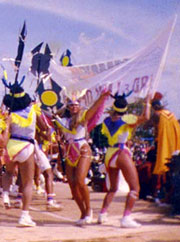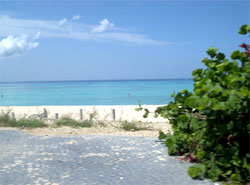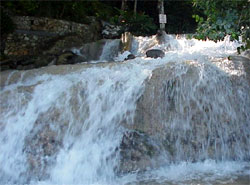|
|
|
|
Top Jamaica Destinations:
Negril hotels Ocho Rios hotels Montego Bay hotels Runaway Bay hotels Falmouth hotels See more hotels in Jamaica
World Destinations:
 Guides » Jamaica » Jamaica - No Problem Guides » Jamaica » Jamaica - No ProblemJamaica - No Problem
As you travel about in the country of Jamaica, you will hear the locals often saying things like, "Yea Mon" and "No problem". This attitude is the Jamaican people, laid-back, easy going, and very accommodating. From the time Errol Flynn visited Jamaica with is Hollywood friends in the 1930s and 1940s, Jamaica has been regarded as one of the most appealing and magical of the Caribbean Islands. You will find a country of mountains, beaches, rainforests, incredible sunsets, and more, making this a tropical paradise.
The thing about Jamaica is that it is unlike any of the other Caribbean islands. For example, on this island, you get the best of all worlds. That means you can stay in a charming villa with a private beach, visit a resort community and party into the wee hours, get involved with the actual life of the people, spending time learning about the history and culture, or focusing more on what they call the "Three R’s" – Reefers, Rum, and Reggae.  Jamaica can be broken down into four primary eras. First are the pre-Colombian years, which occurred before the arrival of Christopher Columbus in 1494. During this time, the island was inhabited by the Arawaks. These people lived in simple villages and lived on gathering, hunting, and fishing. However, when the Spanish came, the communities virtually disappeared. Soon following were problems with the economy, disease, and migration that demolished the native population. From this period, just a few facts and artifacts remain, some that are on display today at a small museum called White Marl. Jamaica can be broken down into four primary eras. First are the pre-Colombian years, which occurred before the arrival of Christopher Columbus in 1494. During this time, the island was inhabited by the Arawaks. These people lived in simple villages and lived on gathering, hunting, and fishing. However, when the Spanish came, the communities virtually disappeared. Soon following were problems with the economy, disease, and migration that demolished the native population. From this period, just a few facts and artifacts remain, some that are on display today at a small museum called White Marl.
The second era began in 1494 when the Spanish took occupation in Jamaica. Thinking they were going there to find gold, they were soon disappointed and instead decided to use the island as a base station for the conquest of the Americas, primarily Mexico, known for gold and silver. However, even with the new arrivals of the Spanish and their slaves, the population never grew much. These people did administer Santiago de la Vega, which is today’s Spanish Town. Additionally, a good portion of the architecture of the original buildings can still be seen today with its wonderful Spanish style. Then in 1655, Jamaica was captured by a British expedition led by two Admirals, Venables, and Penn, just after trying to invade Hispaniola but failing. At this time, the Spanish crown had lost interest in Jamaica so when the British attacked the Spanish did little to offer protection. Just as with the earlier era, influence from the Spanish on political and economical levels was minimal. Today, the only things you really see from this era are some remnants of buildings. The third era of Jamaica involved the slave economy beginning in 1655. After experimenting with the European labor briefly, the British began to import slaves from Africa to work on the sugar plantations. Keep in mind that in its peak, Jamaica was considered the jewels of the English crown because of such great prosperity brought to the English plantation owners and then indirectly to the cities. This type of slavery was based on three things – manufactured goods from England, sugar from the Caribbean, and then the slaves from Africa. International trade was so valuable to the Jamaican people and economy that when the American War of Independence broke out and trade was disrupted between North American and the Caribbean, some 15,000 slaves died of starvation just in Jamaica. From then until the 18th century, the economy was based primarily on the plantation. However, tired of the harsh conditions for some, many slaves escaped to live in small bands within the mountains, becoming known as Maroons. Then as the 18th century closed out, sugar began losing economic value because of the rise in beet sugar along with increasing production costs. By 1838, slaves were emancipated and wages were paid to workers on the plantations. The final era of Jamaica began in 1838 when peasantry was developed. Once the slaves were emancipated, many started their own small farms up in the mountain areas while others chose to stay in the plains. Regardless, struggles over land was always a common theme during the history of Jamaica, leading to the Morant Bay Rebellion during which time George William Gordon and Paul Bogle lost their lives, becoming national heroes. From that time, the national movement for independence started and political ideas of Marcus Mosiah Garvey, a Jamaican hero, precipitated by the reaction of dock and sugar workers in an economic crisis caused by the Great Depression. However, the country emerged strong and from 1944 to 1962, Jamaica saw great political change and economical change. Export of bananas, sugar, and other agricultural goodies helped improve the economy and needing labor for post-war reconstruction, migration of labor to the US and the United States occurred. Finally, independence was reached, social reform was established, and relations with non-capitalist countries opened up. By the 1980s, the Free Zone of manufacturing was established and cultural activities such as sports and music were created. Today, Jamaica continues to grow. While there are still some areas that need improvement such as money for sending children to school, this is a country of heart and soul, a country of people eager to grow. If you like, you can head to Montego Bay in the northwestern region where water sports are premium, to Kingston, the capital city that offers great partying, or to Ocho Rios, a tourist area with warm people, nice restaurants, and the famous Dunn Falls, a 600-foot waterfall that you can climb. Other opportunities include taking a trip up into the rainforest to shop for handcrafted items, visiting the Wassi Art Pottery factory to watch a master potter in action and buy beautiful pieces, or to shop at many of the wonderful stores where beautiful jewelry can be purchased. With this, you can now visit many areas of Jamaica and enjoy magnificent beaches where you can enjoy water sports or simply soak up the sun. Of course, music, especially Reggae, is heard everywhere along with Calypso and Soca. You can also enjoy visual arts and because of the infusion of various ethnic groups, incredible food with influences of Chinese, Middle Eastern, African, Spanish, Indian, Arawak, and British. For example, people will eat sky juice for breakfast, which is a blend of Ackee (red fruit in the photograph), a fruit grown on trees that cooks up like scrambled egg and shaved ice and syrup. Last Updated: 10/19/2006 3:14:00 PM Mode articles for Jamaica Jamaica is a fantastic destination for the entire family. With excellent food, great shopping, pristine beaches, rainforests, scuba diving, waterfalls, historical and cultural sites, nightlife, and more,
Jamaica is a fantastic destination for the entire family. With excellent food, great shopping, pristine beaches, rainforests, scuba diving, waterfalls, historical and cultural sites, nightlife, and more,... continue >>  Montego Bay, Jamaica is a tropical island with beautiful sandy beaches. Because of this beauty, the warmth of the people, the wonderful food, the historical and cultural aspects, and so many activities to enjoy,
Montego Bay, Jamaica is a tropical island with beautiful sandy beaches. Because of this beauty, the warmth of the people, the wonderful food, the historical and cultural aspects, and so many activities to enjoy,... continue >>  Ocho Rios is a unique Jamaican island with extremely wonderful people. While there are some areas of the island where people will push you to buy, buy, buy, most areas are relaxed and full of culture and history.
Ocho Rios is a unique Jamaican island with extremely wonderful people. While there are some areas of the island where people will push you to buy, buy, buy, most areas are relaxed and full of culture and history.
... continue >> |
|
| | |
|
©2025 HotelsRu.com About us Privacy Site map Jamaica - No Problem |
|
 Look for deals on hotels?
Look for deals on hotels?